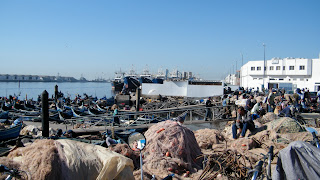We left Dakar on November 28. It was good to leave and get away from the constant sales tactics of local vendors when we went on shore.
I don't blame the vendors for they were trying to make a living but it was surely tiring having to say no and have your hands in your pockets so that they did not hand you something and assume that because it was now in your hands that you had effectively bough it.

The sail to Praia, Cabo Verde was short - we arrived December 1. On the way across we passed a leatherback turtle. It was swimming along leasurely going in the same direction as us. It was probably heading for South America but had more time to get there that we did.
In Praia we were back to hearing Portugese and therefore not understanding a word. Praia was much cleaner than Dakar. We had a crew change here. Ivar (the captain), Jo Leif and Val left. Halvor, the new captain had joined us in Dakar and Kari who had sailed with us from Kristiansand to Cagliari joined us as did Kim.
Pia and I went a shore and stayed off the ship for 24 hours. It was nice to be away from the ship even for one day and night. We found a hotel/resort where we had some great meals.
 Our stay in Praia was short and on December 4 we cast off. The wind was such that we could leave just under wind power. The motor was on but that was just in case of an emergency.
Our stay in Praia was short and on December 4 we cast off. The wind was such that we could leave just under wind power. The motor was on but that was just in case of an emergency. Crossing the atlantic took 17 days. We only sailed and the motor was only started when we were just off Trinidad. Stephanie, the cook fell with a pot of soup which had just boiled and received 2nd and 3rd degree burns on 20% of her body and then the motor was started and we got into Port-of-Spain as fast as we could so she could get to a hospital.
The crossing was amazing. Steady winds from the NE pushed us under nearly full sails at a steady 6 to 7 knots right across the Atlantic. We were rolling as usual but it was a steady gentle passage.
We fished and caught and ate tune, wahoo and dorado.
My students wrote their exams in the middle of the Atlantic and four days before seeing land I had finished my courses.
The students are writing their exam in the Captains lounge.
It was so peaceful crossing to be hypnotic in a way. I some sense I could have cared less if we ever saw land. Our small universe existed in a kind of tranquil equilibrium. There were simple routines, getting up, eating, helping in the galley (I can only peal 50 pounds of potatoes at a time, anything less would seem so pointless), helping to furl the royals at sundown (this was a safety measure), school work and sleeping, nothing complex or overly demanding.
We were saving fresh water so set up a saltwater shower. The water was warm, over 20 degrees.
A few days from South America we sat on deck at 3:30 in the morning and saw the eclipse of the moon.
This was my fourth crossing of the Atlantic. I crossed in 1957 and 58 on Stavangerfjord and in 1964 on Batory, both passenger liners, and now on a tall ship. In the corridor there was a picture of Sørlandet in the mid Atlantic taken from Stavangerfjord. I have crossed on both of these now.
Close to South America a swallow circled the ship. The next day it was dead onboard and we had a funeral at sea for it.
Once in Port-of-Spain our departure and flight back to home was in the blink of an eye. It was great and strange at the same time to be back home and it is taking some adjusting.

















































